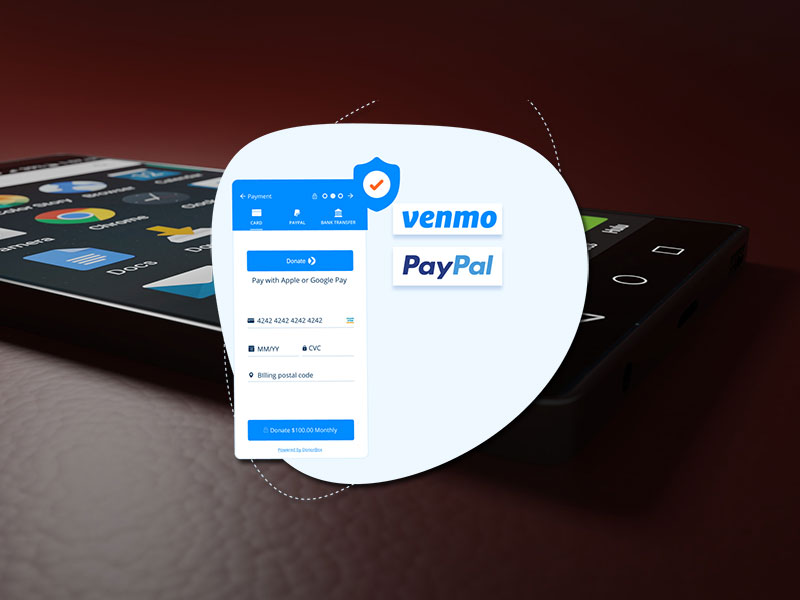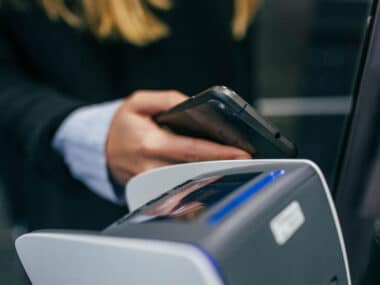When splitting a restaurant check or paying part of a bill, most people don’t give any thought to Venmo fees. Venmo has been downloaded on more than 83 million phones, and its blue icon has become a part of daily life.
It may come as a surprise that Venmo charges fees for many transactions. The app also has privacy settings you’ll want to look into, as well as unique scams to avoid. This guide details all the information you need to stay safe and pay less in fees when using Venmo.

Table of Contents
What Is Venmo?
Venmo began in 2009 as a text message-based payment program between two University of Pennsylvania graduates. In 2012, it was acquired by Paypal, and it has since steadily grown into a popular way to send money quickly between users.
A Venmo account connects to your bank account, debit card, and/or credit card. From there, it lets you transfer money to your Venmo balance. You can then send money to other Venmo users and deposit any money sent to you back into your bank accounts. Sending and receiving money between users is free, but other types of transactions can incur Venmo fees.
Venmo also has a social networking component. Depending on your privacy settings, the payments that you send can be seen publicly on the app by anyone. You can adjust your privacy settings so that the app will only display your payments to those participating in the transaction, but a typical Venmo home screen will still display a string of other people’s payments similar to a Facebook or Twitter feed.
What Fees Does Venmo Charge?
The typical user-to-user transaction on Venmo is free, leading many to assume that all other transactions are free as well. While Venmo doesn’t charge overdraft fees or monthly fees like a typical bank account, there are still tricky Venmo fees you should be aware of.
Transferring Funds to a Bank Account Instantly
Moving money from your Venmo account to your bank account typically takes one to three days. If you choose to expedite the process and transfer the money in minutes, it will cost you a 1.75% fee up to a maximum of $25. This fee was recently increased from 1.5% and a max of $15 in May 2022, so these fast transfers may become even more expensive in the future.
Depositing Checks
Venmo charges a 1.00% fee to deposit government or payroll checks, with a minimum fee of $5. Depositing any other kind of check through Venmo incurs a hefty 5.00% fee.
There’s no charge if you set up a Venmo account as your direct deposit, however.
Sending Money With a Credit Card
Venmo allows you to link your account to a credit card in addition to your bank account. Sending money to another user from a credit card incurs a 3.0% fee.
American Express allows cardholders who download their Amex app to enroll in the Spend & Split program. If you’re enrolled in this program and initiate a Venmo transaction through the Amex app, the credit card fee is waived.
Receiving Commercial Payments
If you’re using Venmo to process payments for your business, you’re paying Venmo fees of 1.9% plus 10 cents per transaction. This applies to any payment sent to a business profile or any transaction marked as “for goods and services.”
Buying or Selling Cryptocurrency
Venmo charges per transaction on all crypto sales and purchases. The fee increases based on price, switching to a percentage instead of a flat fee for transactions over $200.00. Here are the Venmo fees for cryptocurrency transactions:
- Between $1.00 and $4.99 costs $0.49
- Between $5.00 and $24.99 costs $0.99
- Between $25.00 and $74.99 costs $1.99
- Between $75.00 and $200.00 costs $2.49
- Between $200.01 and $1,000.00 incurs a 1.8% fee
- Over $1,000 incurs a 1.5% fee
It’s not hard to see how these per-transaction fees can add up over time, making it expensive to buy or sell cryptocurrencies through Venmo.
Here are the common transactions that don’t incur any Venmo fees:
- Opening an account
- Maintaining an account (meaning Venmo has no monthly fees, no matter your balance)
- Overdrawing your Venmo account (if you have insufficient funds, the payment simply won’t go through)
- Purchasing items or services online
- Sending money to users from your Venmo balance
- Sending money to users from your bank account or debit card
- Adding money to your Venmo balance from a bank account
- Receiving money in your Venmo balance from other users
- Receiving refunds from purchases to your Venmo balance
- Setting up your direct deposit to go to your Venmo account
- Transferring money from your Venmo account to your bank account with a wait time of 1-3 days
To Venmo’s credit, the company is transparent about its fee structure. All of these fees are clearly explained on their website.
How Do Venmo Fees Compare to Other Payment Apps?
You may be wondering if different payment apps may be a better choice to avoid fees. Here’s how Venmo’s fees compare to other popular third-party payment methods.
PayPal
PayPal owns Venmo, so they charge comparable fees. Paypal, however, has different sets of fees for consumers and merchants. The fee structure for PayPal is much more complicated than Venmo’s, but here are the key similarities and differences.
- Using the Friends and Family Send feature to send money to individuals (similar to Venmo) is free from a bank account or PayPal balance. Sending from a credit card incurs a 2.9% fee instead of 3.0%. The fee can be also waived through the Amex app’s Send & Split feature.
- Cryptocurrency fees are the same.
- PayPal charges a 1.5% fee for their instant transfer, while their free transfer takes only one business day, as opposed to one to three.
- Merchant transactions typically come with a 3.49% fee, plus extra charges for international currency conversion.
Zelle
You’ve probably seen advertisements for Zelle on your mobile banking app. It’s a money transfer service that’s compatible with most bank accounts.
If you want to send money directly from your bank account to a friend or family member, Zelle charges no fees and the money is available right away. This is a smart way to get around the 1.75% fee per instant transfer from a Venmo balance to a bank account.
How Can You Avoid Venmo Fees?
Venmo fees are generally low, but they can still add up. Thankfully, they’re fairly easy to avoid.
Don’t Send Money From a Credit Card
The best way to avoid Venmo’s high 3.0% fee for sending money from a credit card is to send it from a bank account or debit card, instead. This also helps with budgeting, as you’re not sending money you don’t currently have.
Enroll in American Express Send & Split
Times are hard, and we recognize that sending money from a credit card may be unavoidable in some situations. If you must send money from a credit card, you can avoid the fee by enrolling in the American Express Send & Split program through the Amex app.
The app works similarly to Venmo in that you can transfer money from your American Express balance to an Amex Send account on the app. Then, you can send that money to a Venmo user with no fee. The amount transferred to the Amex App will show up as a charge on your American Express balance at the end of the month, and it will still be subject to your APR. It won’t be eligible for any rewards.
Set Up Direct Deposit
If you’re depositing payroll checks manually to the app, you’re losing a significant chunk of your income to Venmo fees. Retain that money by either depositing those checks directly at your bank or setting up your direct deposit to go to Venmo.
Don’t Confuse Your Venmo Balance With Your Bank Account
One of the more difficult fees to avoid is the instant transfer fee of 1.75%. If you use Venmo regularly, you may be counting on money from friends to pay important bills like credit cards, utilities, or rent. It can be easy to mentally lump your incoming Venmo payments in with your bank account balance, only to find you have to pay the instant transfer fee to cover a bill on time.
Instead, plan ahead and use Venmo’s free transfer to avoid the upcharge. Create a mental barrier between your Venmo balance and the money in your actual bank account. Ensure upcoming bills can be paid with the bank account only.
Do You Have To Pay Taxes on Venmo Payments?
Beginning in 2022, Venmo is required to report any business transactions over $600 to the IRS as taxable income. This doesn’t mean that any money you receive via Venmo (for example, your friends paying you back for their share of a bar tab) can be taxed. It does mean, however, that you have to be careful when classifying payments you’ve received on the app.
The IRS advises that if you’re using Venmo, you need to designate each non-business transaction as between family and friends and make a quick note of what the payment was for. Don’t mark it as a business transaction or a transaction for goods and services. Otherwise, if you receive payments of more than $600 in one year, the IRS will flag it as income and send you a 1099 form.
What Are Venmo Privacy Settings?
In addition to Venmo fees, the privacy settings on the app trip up many users. Financial transactions were generally considered private information before Venmo. For older users, in particular, broadcasting the amounts of everyday purchases may seem bizarre.
The app’s privacy settings and design were at the center of a 2018 FTC lawsuit that Venmo eventually settled. The lawsuit alleged that navigating the app’s settings was unintuitive and ran against most consumers’ expectations of privacy in financial transactions.
Put plainly, the default setting was to share all transactions, including their specific amounts, with anyone on the app. If a user set their transactions to “participants only,” this didn’t actually keep their information off of public feeds. The other participants could still broadcast payments unless the user changed even more default settings.
The good news is that, after settling the lawsuit, Venmo made these settings much easier to control. Simply go to the privacy settings section of the app and choose “Private,” and all of your transactions will only be visible to you and other participants. This is a good way to avoid being targeted for Venmo scams.
What Are Common Scams on Venmo?
Scams may not technically be Venmo fees, but they can still deliver a big hit to your bank account. Even if you can identify most pitfalls, like promises to double your money, Venmo-specific scams can be hard to spot.
“Accidentally” Sent Money
Because Venmo is a fast-moving platform, you or someone else could feasibly send money to the wrong John Smith. Scammers know this, and they may send you a large payment claiming it was a mistake. If you accept the payment, read their message, and then send them the money back, the scammer will cancel their initial transaction and leave you in the red.
To be safe, always refuse unexpected Venmo payments from people you don’t know. If you accept one of these payments by accident, contact PayPal support to reverse the transaction. Don’t simply send the same amount back.
Pretending To Be Friends or Family
Beware of scammers pretending to be your relatives or friends, especially ones you haven’t seen in a while. Always discuss payments in person or over the phone before sending money on Venmo.
Simple Measures Can Help You Avoid Venmo Fees
Half of avoiding Venmo fees is simply knowing about them. You can save money by not sending Venmo payments from a credit card, setting up direct deposit instead of entering payroll checks, planning ahead to avoid the need for instant transfers, and avoiding scams. For more sound money management advice, check out helpful budgeting tips on Fiscal Tiger.





